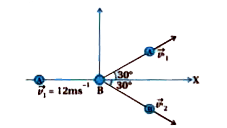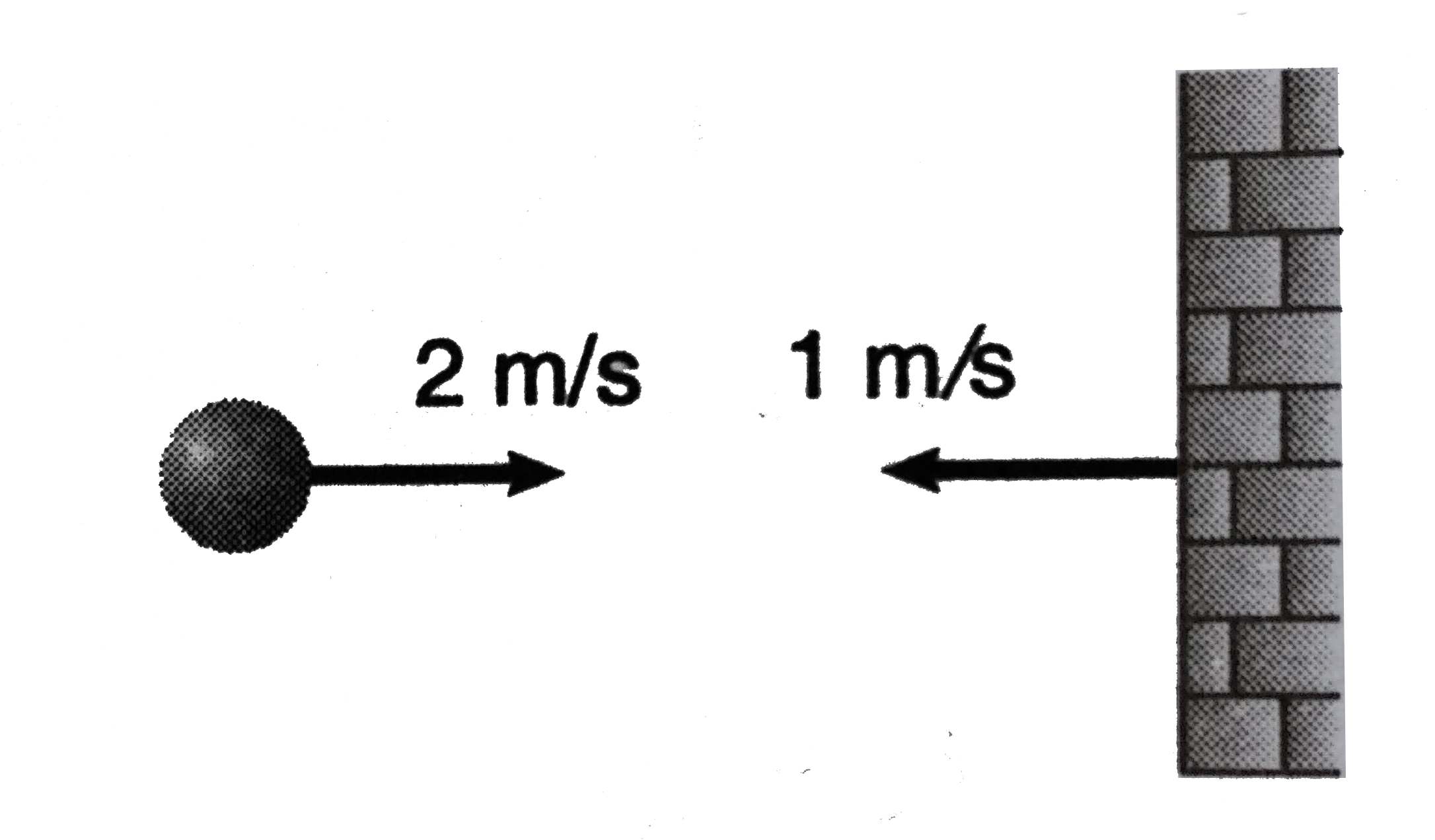A ball moving with a velocity of 12ms−1 collides with another identical stationary ball . After the collision they move as shown in figure . Find the speed of the balls after the collision . Also , decide whether the condition is elastic or not .
 Solution in Gujrati
Solution in Gujrati
Suppose the mass of each ball be m . According to the law of conservation of momentum by taking X - components ,
mv1=mv1cos30∘+mv2cos30∘
∴v1=√32v1+√32v2 ....(1)
Taking Y - components
p=mv1sin30∘−mv2sin30∘
0=v12−v22
∴0=v1−v2
∴ From equation (1) ,
The velocity before collision v1=12m/sandv2=0
∴ The kinetic energy of system before collision
K1=12mv21+12mv22
K1=12×m×(12)2
K1=72mJ ....(1)
Velocity after collision v1=4√3m/sandv2=4√3m/s
∴ The kinetic after of system after collision .
K2=12m×48+12m×48
∴K2=12m×48+12m×48
∴K2=24m+24m
∴K2=48mJ .....(2)
∴ From equation (1) and (2) ,
K2>K2 so the kinetic energy is not conserved , the collision is not elastic .
Topper's Solved these Questions
- BOOK - KUMAR PRAKASHANCHAPTER - WORK, ENERGY AND POWER EXERCISE - SECTION - C Objective Questions (VSQs)52videos
WORK, ENERGY AND POWER
- BOOK - KUMAR PRAKASHANCHAPTER - WORK, ENERGY AND POWER EXERCISE - SECTION - D NCERT Exemplar Solutions (Multiple Choice Questions)21videos
WORK, ENERGY AND POWER
- BOOK - KUMAR PRAKASHANCHAPTER - WORK, ENERGY AND POWER EXERCISE - SECTION - B Numericals (Numerical From Textual Exercise)42videos
WORK, ENERGY AND POWER
- BOOK - KUMAR PRAKASHANCHAPTER - WAVESEXERCISE - SECTION-F (Questions From Module) (Sample questions for preparation of competitive exams)23videos
WAVES
Similar Questions
If →A=2ˆi−2ˆjand→B=2ˆk then →A.→B……
03:16View SolutionAn electron and a proton are moving under the influence of mutual forces . In calculating the change in the kinetic energy of the system during motion , one ignores the magnetic force of one on another . This is , because
View SolutionThe sign of work done by a force on a body is important to understand .State carefully if the following quantities are positive or negative :
(a) work done by a man in lifting a bucket out of a well by means of a rope tied to the bucket .
(b) work done by gravitational force in the above case ,
(c ) work done by friction on a body siding down an inclined plane ,
(d ) workdone by an applied force on a body moving on a rough horizontal plane woth uniform velocity .
(d) work done by the resistive force of air on a vibrating pendulum in bringing it to rest .05:41View SolutionIn a standing wave formed by two atoms separated by 1.21Å, there are 3 nodes and 2 antinodes. Find its wavelength.
04:56View SolutionA ball is moving with velocity 2m//s towards a heavy wall moving towards the ball with speed 1m//s as shown in figure. Assuming collision to be elastic, find the velocity of ball immediately after the collision.
02:25View SolutionA ball of mass m moving with a speed u_(1) collides elasticity with another identical ball moving with velocity u_(2) . (a) Find the velocities of the balls after collision if the impact is direct. (b) Find the angle between velocities after collision if they collide obliquely and u_(2)=0
07:02View SolutionA ball moving with a speed of 9m/s strikes an identical ball at rest, such that after the collision, the direction of each ball makes an angle of 30∘ with the original line of motion. Find the speeds of the two balls after collision.
View SolutionA ball moving with velocity of 6 m/s strikes an identical stationary ball. After collision each ball moves at an angle of 30^(@) with the original line of motion. What are the speeds of the balls after the collision ?
View SolutionA ball moving with speed u collides with an identical ball at rest. The velocities of two balls after collision are (If the collision is elastic):
01:09View SolutionProve that in a two dimensional elastic collision of a moving ball with another stationary identical ball, the two balls move perpendicular to each other after collision?
02:53View SolutionA ball moving with a velocity of 6 m/s strikes an identical stationary ball. After collisions each ball moves at an angle of 30^(@) with the original line of motion. What are the speeds of the balls after the collision?
02:50View SolutionA ball moving with a velocity of 6 m/s strikes an identical stationary ball. After collision each ball moves at angle of 30^@ with the original line of motion. Assuming that the collision is elastic, what are the speeds of the balls after the collision?
02:16View SolutionA ball of mass m moving with velocity v collides head on elastically with another identical ball moving with velocity - V. After collision
View SolutionA ball is moving with velocity 2m/s towards a heavy wall moving towards the ball with speed 1m/s as shown in figure. Assuming collision to be elastic, find the velocity of ball immediately after the collision.
 05:36View Solution
05:36View SolutionA ball is moving with velocity 2m//s towards a heavy wall moving towards the ball with speed 1m//s as shown in figure. Assuming collision to be elastic, find the velocity of ball immediately after the collision.
View Solution

